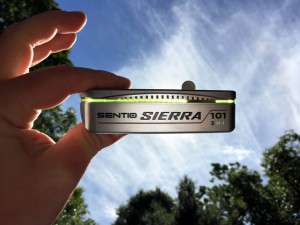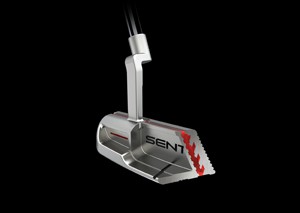
Club makers use words like NEW, AMAZING, THE LATEST, etc. to promote their clubs and putters are no exception. When I first saw the Sierra 101 from Sentio and talked with Jim Varney, the company’s president, it was evident perhaps their new Sierra 101 putter did have something that was new and even unique.
Sentio’s idea is to completely isolate the putter face from the putter body with a layer of TPE (thermoplastic elastomer) which, when made with different properties, would change the feel of the impact and indeed the amount the ball rebounds. This means the feel can be matched to individual preference and the speed of the greens normally played.
Good players know feel is the critical factor in making more putts.
There are three TPE layers or “feels” available: green is soft for fast green speeds, blue for slower greens and red for medium speed greens.
The testing of the Sierra 101 with a red TPE layer was over 10 rounds on medium speed Bermuda greens and it was evident from the first this patent-protected idea worked and worked well.
Distance control was excellent almost eerie and as experience increased it became simply a case of determining the putt’s line and hitting it. Obviously not every putt went in but the confidence from knowing the distance would be correct meant three putts were virtually a thing of the past.
Other than the TPE layer each of the Sierra 101 modern blade models has a medium toe-hang and a plumber’s neck hosel and the two-part body of milled stainless steel. A face balanced mallet style is in the works and should be ready by the time of the PGA Show in January.
 Varney responded to questions with answers showing both the hard work and commitment to the Sierra 101.
Varney responded to questions with answers showing both the hard work and commitment to the Sierra 101.
ET: How did you come up with the idea of the “insert” in the middle of the head instead of on the face like most other putters?
JV: My business partner and I have a background in product design and engineering, so we are constantly looking at everyday things and thinking of ways to improve them. As an avid golfer (and equipment nerd) I noticed so much technology and cutting-edge manufacturing going into drivers, metal woods and irons while putters were very traditional. There seemed to be a lot of room for innovation there especially in regard to feel; most of the new ideas from the big brands dealt more with alignment even though 85% of golfers say feel is most important. We decided to apply our knowledge of engineering and manufacturing to approach the problem from a fresh perspective. The breakthrough came when we realized that by molding a dampening agent in the middle of the head we could change the feel response in ways that are impossible with face inserts or solid putters. This construction also gave us the ability to improve forgiveness and MOI, and also create alignment features – it was like an all-in-one technology. We knew this would be technically difficult but certainly feasible, using a method called Insert Molding. We then verified our ideas with experiments and research, culminating in our patent in 2013.
ET: The Sierra 101 loft is only 2-degrees which is less than most others which are 3- and 4-degrees for what reason?
JV: Greens in general are getting faster than they were even 5 years ago, which means you don’t need as much loft to launch the ball out the indentation it’s sitting in on the green. We want to create forward roll as soon as possible, and the grooves and lower face loft help achieve that. The hosel design allows for loft/lie bending anyway, so golfers that get custom fit with our putters can have this adjusted to their preferences.
ET: Can you share COR values of your putter versus others? Readers are used to thinking in terms of the USGA .083/.086 maximum for drivers, etc.
JV: There are several ways of measuring COR, we use the static drop method: drop a golf ball (ProV1) from a set height onto the face of the putter, which has been immobilized, and measure the rebound height. This is important because we wanted to measure the COR of the face independent of other design elements, such as the hosel and shaft. The ratio of rebound height to drop height is the COR value.
Using this method, a relatively firm face insert has a COR of about .82 and a solid milled 303 stainless steel putter has a COR of .87. They may seem close, but that represents about 13-15% difference in energy transfer between the two. On a 20 foot putt, that difference equals 3 feet. Our Sierra models have COR values in the range of .83 to .86, spanning the range between the two extremes.
ET: What’s the reason the vertical grooves the TPE fills are deeper in the center and are eliminated towards the heel and toe?
JV: The vertical grooves in the back of the face replace some of the heavy steel with lighter TPE. This has two effects:
- It further increases MOI of the head
- It locally reduces the mass of the face in the center, making the sweet spot a little less hot. This makes the putter more forgiving on off-center strikes.
ET: The model you sent me has what I judge as a 45-degree toe hang so are all the models the same? Why did you choose that as opposed to say a face balanced weighting or a 90-degree toe hang?
JV: As an independent start-up we decided to start with a single head shape and expand from there. The Sierra 101 head style was designed to fit as many players as possible, so we chose a middle of the road “4:00” toe hang which could be used by almost everybody. True straight-back-straight-through (SBST) players may not like it, but even some of those folks find it easy to control. I’ve heard from many people that they like the way it “sets up”. I think this is a combination of the square lines and the balance at address.
ET: Each model has and L-shaped hosel (plumbers neck?) and is heel mounted. What is your reasoning?
JV: Again, starting with a single body style was going to be necessarily limiting, so we decided to go “classic” with a full-offset plumbers neck hosel. There is actually no limit to the shapes and styles we can do with our technology, which is one of the cool things about it. There are some great technologies in putters out there that require certain shapes or forms or balance points – we don’t have any of those restrictions. Our next body styles will have different hosels and balances – a mallet is in the works too. We designed the Sierra 101 with a nod to tradition, but with a vision pointed squarely in the future.
Negatives: Alignment using the exposed top of the TPE layer may not be for everyone and certainly those who presently use a face-balanced putter may find the toe weighted Sierra 101 an adjustment. Not really as a negative but a caution, downhill putts because the hit is so solid tended to run out more than usual that the model I previously was using.
Recommendation: The Sierra 101 from Sentio Golf is really different and unique due to the use of the proprietary TPE layer and this alone makes it one you should consider if only for the feel the layer provides. Priced at $299, it may be purchased on SentioGolf.com and select golf shops.
